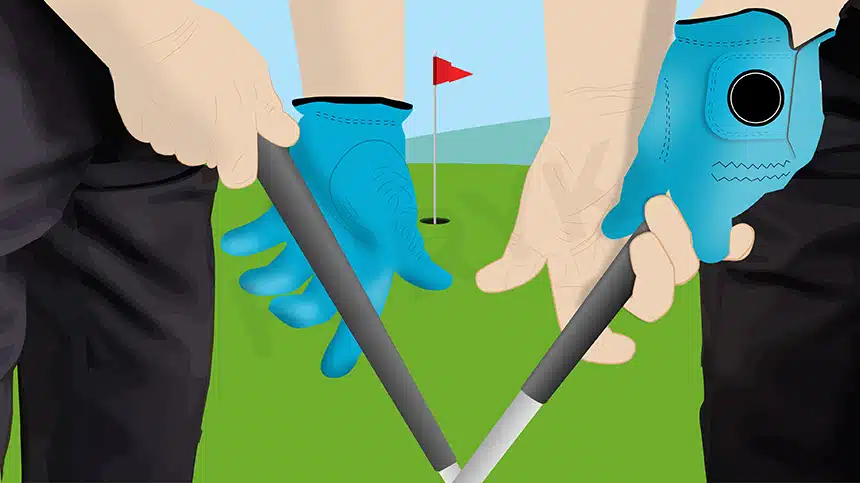Golf swing, a complete golf swing starts from a proper golf grip. So how to grip a golf club is a very common topic of discussion by many across the arena of golf. And if you neglect this, factors like consistency, distance, speed, power, and accuracy are sure to suffer. Because the grip is indeed the only point of contact between your club and hands.
The way you hit your shots, a greater part of that is determined by how you’re holding the golf club. And not how experienced you are as a golfer or the appearance/aesthetics of your swing.
Rather the speed and direction of the club as well as the clubface position through impact – these are instrumental. And are 100-percent controlled by your golf grip!
In This Post
- How to Grip A Golf Club for Beginners – Step-by-Step Instructions
- A Proper Golf Grip – Why Is It So Important?
- Different Types of Golf Grips
- Different Types of Grip Strength
- Holding A Golf Club – Right-Hand vs. Left-Hand Orientation
- Holding A Driver vs. Holding A Putter
- Correcting Your Golf Grip – What Are Your Faults?
- A Very Simple Golf Grip Cheat Sheet
- Golf Grip Pressure – How Tight Should You Grip Your Club?
- Thumb Placement In Your Golf Grip – Short or Long Thumb Grip?
- Proper Golf Club Grip – Most Commonly Asked Questions
- How to Hold A Golf Club Properly?
- How Do Position the Hands On Your Golf Club?
- How to Grip A Golf Club Using the Right Hand?
- How to Grip A Golf Club Using the Left Hand?
- How Far Down to Grip Your Golf Club?
- How Far to Choke Down On Your Golf Club?
- Why Do Golfers Interlock Fingers In the Grip?
- Why Does Golf Grip Affect the Clubface So Much?
- How to Correct Ball Flight with Golf Grip?
- How to Hold A Putter?
- Do You Hold Drivers and Irons Using the Same Grip?
- How to Grip A Golf Club Around the Greens?
- How to Change Golf Grip Fast?
- Final Words
How to Grip A Golf Club for Beginners – Step-by-Step Instructions
How to hold a golf club to get a proper golf grip is something that beginners want to know. And sometimes even seasoned players feel the need to reset or correct their grip that may have gotten a bit weak or faulty along the way. So here’s how to establish that solid foundation with your golf club grip.
Step 1: Hold the golf club in front of the body at waist height at a 45-degree angle. The club should be in a horizontal position to the turf with its face squared up.
Step 2: Grab the golf club using the left hand. Stretch those fingers and align the shaft with the left palm for that club handle to form a diagonally straight line across the fingers.
Step 3: Close the grip of your left hand around your golf club. Make sure that palm’s heel portion is resting along and over the club grip’s top edge (at this point, if you can still see the handle tip, then know that you’re doing it right).
Step 4: Now it’s time for you to rotate that hand toward the right till two knuckles come into view when looking down. That forms a solid, neutral grip – best for most golfers out there. Your grip now should be able to exert enough pressure for holding the golf club yet still bending the wrist.
Step 5: Bring in the right hand right about now. Its heel portion is placed over the left thumb to cover the left hand. Now close the hand, so the forefinger and thumb are in a V-shaped position pointing in the direction of your sternum center.
A Proper Golf Grip – Why Is It So Important?
The importance of a proper golf grip can never be over-estimated in that clubhead-speed-boosting golf swing sequence. You should never grab your golf clubs like you do a baseball. Even though it may seem like a more productive or fun thing to do, a baseball-like grip isn’t going to benefit your shot in any way when on that range.
How you grip your club matters a lot if you want to produce a solid golf swing. The grip, no doubt, sets the most solid foundation for the swing because that’s the only point of contact there is between your golf club and you.
The positioning of your hands on your club also determines how much control you have on that stick. Meaning you control how the clubface is positioned at impact – square, open, or close. When done right, a solid golf grip creates a more fluid and natural wrist movement, which adds more strength and speed when moving your club.
Different Types of Golf Grips
First of all, please keep in mind that there’s no “universal” or “perfect” fit as far as golf grip is concerned. Nonetheless, here are the most common ones because it goes without saying that knowing the differences goes a LONG way, and I mean that literally since distance is so important in golf…
The Overlapping Golf Grip
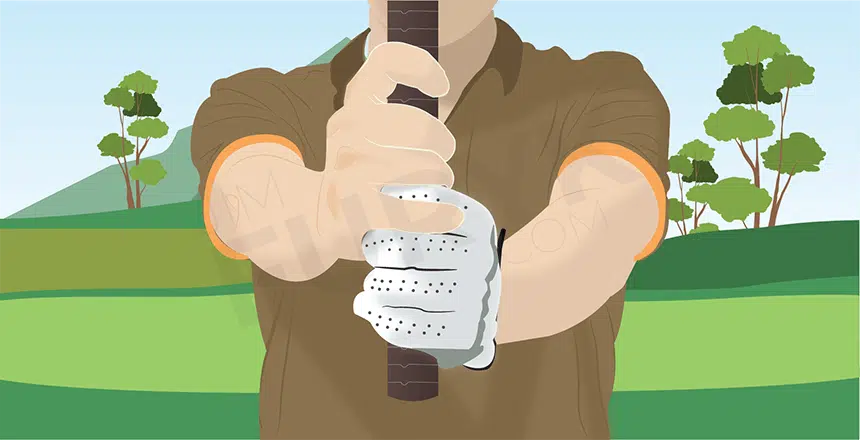
It’s the most common one indeed, that Harry Vardon preferred (that’s why it’s also known as the ‘Vardon’ overlap golf grip). And it involves placing your pinkie finger (right-hand pinkie for the right-hand golfer) between the middle and index finger of the other hand (the left one).
What this kind of ‘overlapping’ does is balance things out in case you have larger hands, as Vardon did.
Now keep in mind the following instructions in the case of this overlapping golf grip…
- Since there’s more wrist hinge and hand movement freedom with this one, an increase in clubhead speed is inevitable, so expect your shot distances to also increase.
- If there is any so-called “perfect” golf grip, it has been best described as the overlap grip simply because this allows your both hands to form the ideal union for control and power.
- But then if you have smaller or weaker hands, avoid overlapping as it seems to be a more challenging task to accomplish on its own.
The Interlocking Golf Grip
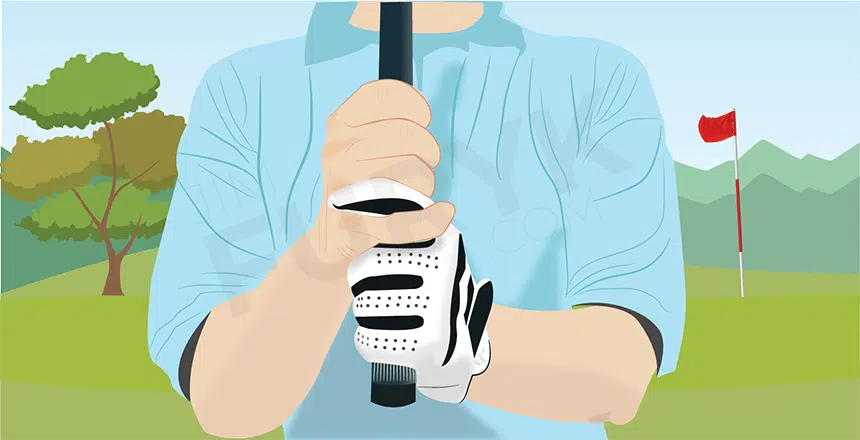
The Tiger Woods (larger hands) and Jack Nicklaus (smaller hands) preferred grip, the 10-finger interlocking grip consists of interlocking your right-hand pinkie finger with the index finger of the left hand (for right-hand orientation), so your hands are placed closer together.
The advantage here is the interlocking part itself, which allows both hands to work together for adding power to the golf swing.
Factors to consider with the interlock golf grip…
- Make sure your hands remain connected all throughout your swing.
- If you have smaller hands or lack the required physical strength (for example, younger players), it then becomes much easier for you to grip your golf club this way.
- On the downside, the interlocking grip might compromise feel and clubhead speed (since fewer fingers do the gripping).
Related: Overlapping vs Interlocking Golf Grip – Which Is the Better?
The 10-Finger Golf Grip
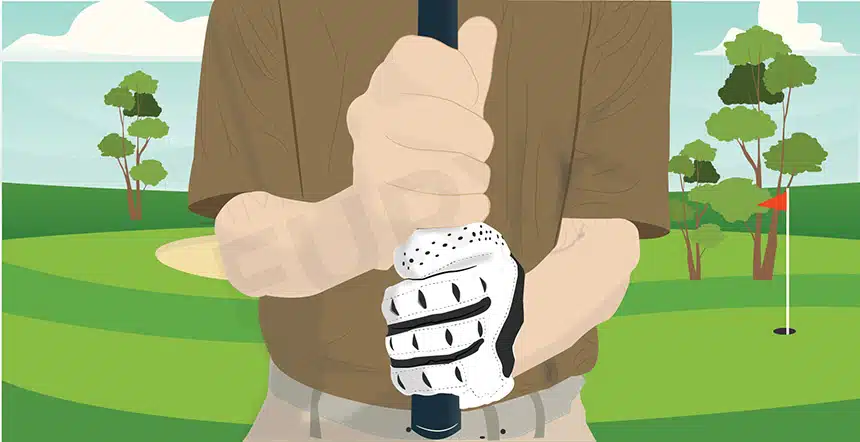
As the term explains, you use all your finger for this particular grip on your golf club. It’s known as the best golf grip for beginners because of how comfortable it feels. Hence, not for professional players and low handicappers. Yet it’s plenty powerful because all fingers come into contact with the grip (that’s why it’s often referred to as the baseball grip too). And that also works for smaller hands as well.
Every finger of yours is placed on your club, with your hands side-by-side resting. So if you’re a right-handed player, then your right thumb lays down that shaft from your left thumb.
What works and doesn’t work with the baseball or 10-finger grip…
- Almost everyone knows how to swing a baseball, thus the feeling is more natural.
- Because of too much freedom created by this grip, boosting clubhead speed becomes possible as a result of whipping that golf club because of more wrist hinge or cock.
- However, you lose clubface control. So the ‘extra’ yardages come at a cost indeed.
- Another drawback of the 10-finger golf grip is that PGA Tour players rarely showcase it, so there’s no “ideal” example you have that you can mimic for yourself. Plus, not many golf instructors recommend this particular method.
Different Types of Grip Strength
Improving your golf grip strength or even adjusting your grip strength is very, very important to maintaining grip pressure throughout that golf swing of yours.
Although a too strong grip doesn’t imply that your grip on the club is too tight. Instead, the direction your hands are positioned in on that golf club is what’s implied here. And that, in turn, has a direct impact on your shot’s direction, height, and more.
Now let’s find out what type of grip strength is the most beneficial for YOU!
Strong Golf Grip
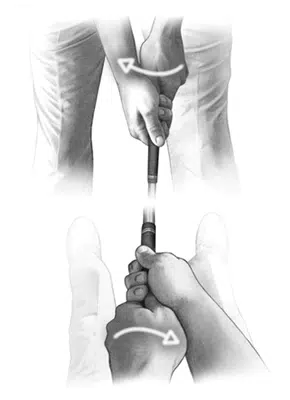
You know that V-shaped placement of your hands and thumbs when gripping your club? When this ‘V’ shape is pointing toward the right of your head, know that you have a pretty strong grip. And it actually helps when it comes to preventing slices or if you swing over the top.
With a strong grip like this, you can also achieve a golf swing that takes on a more inward-to-outward movement plus the clubface then ends up closing more at impact. Therefore, you’re more likely to hit shots spinning from the right to the left.
Weak Golf Grip
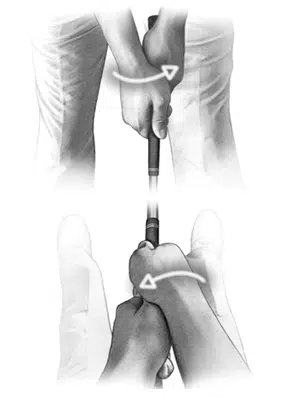
Weak is the opposite of strong, thus the ‘V’ shape here is pointing toward the left of your head. So a clubface less closed through impact is what you get, along with a golf swing that’s more outward-to-inward.
Weaker grips are the best for those more frequently hooking their shots since the clubface, in this case, closes more slowly at impact. It also helps golfers whose swings are produced from a little too from the inside.
To fight a hook, slightly weakening the grip is surely worth a try!
Neutral Golf Grip
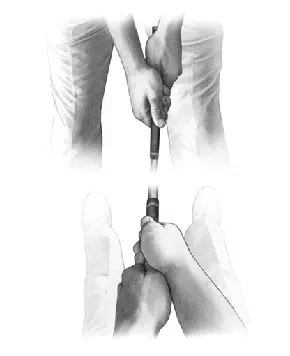
When that ‘V’ shape is pointing upward i.e. towards your nose, it’s a neutral grip. And that works in the favor of golfers who hit their shots fairly straight. It’s also perfect for those who want to play right-to-left (draw) and left-to-right (fade) shots.
So if your golf swing mechanics are solid and you don’t dramatically lose shots in either direction, the neutral grip is the best for you.
Holding A Golf Club – Right-Hand vs. Left-Hand Orientation
The technique of golf grip is exactly the same as right-handed orientation for left-handed golfers except that you take on the opposite hand placement. So for lefties, the left hand is positioned higher with the right hand at the club handle edge.
As for which hand orientation is right or better, there’s no one-size-fits-all solution here. Meaning you should choose between the two based on what feels the most comfortable and natural.
But there are advantages of left-handed golfers playing right-handed clubs. And vice-versa, as Phil Mickelson has proved. Swinging left-handed, he gained the upper hand in terms of letting his stronger arm, lead arm, pull the golf club down.
But then Phil Mickelson is a professional golfer who has won 2 PGA Championships, 1 Open Championship, 3 Master titles, and lots more such esteemed events. So, once again, go with whatever feels natural and comfortable to YOU.
As for left-handed golf clubs, top brands like TaylorMade, Callaway, Ping, Titleist, etc. have almost everything left-handed as well.
Holding A Driver vs. Holding A Putter
You have multiple types of clubs, right? So you can’t use the same grip you do for your driver for, let’s say, your putter as well. The former is for hitting shots off the tee while the latter is used only on the green.
How to Grip A Driver Correctly
These correct golf grip for driver instructions are for right-handed golfers. So if you’re left-handed, then just use the opposite hand placement but the technique stays the same.
Grip your golf driver at the handle’s base using the left hand. Rotate this hand to bring your middle and index fingers’ knuckles into view. Then place the right hand in a way that it overlaps the middle and ring fingers of the left one. Now your right hand’s index finger and thumb create a ‘V’ shape that arranges itself along the center of the torso.
How to Grip A Putter Correctly
Stretch your left hand (if you’re a right-handed golfer) and hold your putter that way. Its handle has to pass along the middle of the hand. Now, follow the same right-hand placement to set it under the left one.
But with putter grip, there are quite a few variations. Such as cross-handed (personally, I prefer this one), overlap, and claw. So you can try them all out and then pick a grip that feels the most comfortable to you.
Correcting Your Golf Grip – What Are Your Faults?
There are many golf grip mistakes that can actually ruin your whole game. Is your stance off? Does the grip not feel comfortable at all? These are only common problems/errors that can easily be fixed. So here are the most rookie mistakes you may be unknowingly making.
1. Squeezing Your Club Too Hard
Don’t create a “choke” of a grip. Hold your golf club just tight enough to prevent it from flying away yet soft enough to avoid crushing it. The middle ground between keeping your hands from shifting and providing sufficient “give” in terms of grip.
2. Gripping “Up”
Can you see the handle tip? If not, you’ve placed your hands too high. Instead, position the left hand more down along that handle. This way, you can actually see this handle. And then change the placement of the right hand accordingly.
3. Incorrect Positioning of Your Trail and/or Lead Hand
Your trail hand is the right hand if you’re a right-handed golfer. So check if this hand of ours is placed on the club in a way that the forefinger and thumb are forming that much-needed and sternum-pointing ‘V’ shape.
As for the lead (left hand), this hand’s middle finger knuckle and ring finger knuckle you should be able to see. The handle has to diagonally run down the fingers.
4. Underestimating or Neglecting the Basics
Sometimes getting the correct golf grip pressure can be as simple as going back to those basics. So put down your golf club, step away, and then start over completely.
Speaking of basics…
A Very Simple Golf Grip Cheat Sheet
How to hold a golf club properly? The most basic, straightforward instructions.
- Start with the left hand (if right-handed).
- The handle should diagonally run across the fingers of your left hand.
- Once you close that hand over the club handle, check the knuckles (you should be able to see them).
- The handle tail must not be covered at this point with the left palm.
- Now the forefinger and thumb of the right hand form a ‘V’ shape over the handle.
- Make sure the grip is natural and loose and avoid over-squeezing the golf club.
Golf Grip Pressure – How Tight Should You Grip Your Club?
This is not about grip strength (strong, weak, and neutral) that I discussed earlier. Rather I’m referring to grip pressure i.e. how much pressure (tight or loose) you apply with your hands on the club. In that case, how tight should the grip or pressure be?
Here at this point, I’d like to highlight the most commonly known fact. Beginners and amateurs, in most cases, grip their golf clubs too tight. And when you do that, unwanted tension takes form, which can prove to be harmful to your forearms, shoulders, back, and neck. Let alone a too tight pressure leading to creating an unnatural tempo in your swing as well as an overall choppy golf swing.
So what is the “right” amount of pressure or tension then? I have always practiced maintaining a consistent golf grip for my every kind of shot. Ask any other player or instructor and they’ll tell you the same thing. Think as if your golf club is a tiny bird or something like that. So you naturally will not hold that little, delicate creature too tight, correct?
But then doesn’t this advice apply only to those golfers with really, really strong hands? I mean average players may not have the same feeling in their hands. Nonetheless, the goal here is to hold or grip your club and not choke it. And if your hands are not as strong, then maybe just a tad tighter.
What Do PGA Tour Players Have to Say About Grip Pressure?
Top-class golfers like Dustin Johnson, Tiger Woods, Ricky Fowler, etc. have quantified grip pressure. So that magic number, on a scale from 1 to 10, is anywhere between 5 and 7.
But then it also depends on what golf club or shot you’re playing. A very good example would be keeping the grip pressure 7 when shooting out of rough or if you have to hit the shot from a challenging bunker’s buried lie.
On the other hand, maintain a grip pressure of 2-3 for when using a driver as well as fairway woods. This means lighter pressure, thus minimal forearm tension. Too tight and you certainly will not be able to generate that distance-boosting naturally smooth tempo and power.
Ben Hogan advised applying pressure just on your index finger and the pad portion of your left hand. And on the right one, apply pressure using only your index and middle fingers. The forefinger and thumb of your right hand are merely placeholders.
Then Jack Nicklaus also shared his pearls of grip pressure wisdom. Your last 2 fingers of your left hand apply the pressure while also pressing your golf club shaft into your palm. As for your right hand, use your index and middle fingers for pressure.
And now my final say is that you should always maintain a consistent force of pressure in both your hands all throughout your golf swing. Once you remind yourself this very simple, straightforward call-to-action, you’ll instantly realize that you’re not maintaining that consistency during the follow-through part of the swing sequence or if you end up with a single-arm finish.
Thumb Placement In Your Golf Grip – Short or Long Thumb Grip?
If you’re a beginner, then it’s only common to not know the answer to this question. The correct thumb placement is a mystery to many beginner golfers. And, no doubt, how your thumb is positioned in the grip matters since it determines not just clubhead speed but also top-of-the-backswing control.
What has been already established is that the short thumb version limits your range of movement while the long thumb grip doesn’t restrict at all. On the contrary, it increases that sphere of motion.
The meaning of a long thumb grip (best for you if you want your golf swing to lengthen) – your thumb vertically runs down the club shaft, so it’s separated from your other 4 fingers.
The meaning of a short thumb grip (best for you if your golf swing is already extremely long) – your thumb travels directly down the shaft’s right side, so it’s positioned right beyond that forefinger.
Achieving more distance is such an important part of almost every golfer’s game. Nevertheless, golf club control is also a very crucial aspect because it too can increase your distance potential and produce solid, better strikes. This is why the short thumb approach for your grip doesn’t deserve to be dismissed.
You can do both as well depending on your mood. It’s never a bad idea to try out different hand positions and grip styles. Experiment as much as is needed to arrive at something that actually works in the favor of your golf swing to create the required ball flight.
Proper Golf Club Grip – Most Commonly Asked Questions
How to Hold A Golf Club Properly?
Meaning what is a proper golf grip, right? First of all, every golfer uses his/her own approach because there’s surely no one-size-fits-all way to grip the club. But there are general instructions.
So if you’ve just started playing golf, the perfect starter grip (right-hand orientation) consists of a more relaxed grip. The golf club handle should diagonally run down your left-hand fingers and into that palm, which are positioned toward the top of the grip.
If you can see your middle finger and index finger knuckles when looking down that golf club, you’re doing it right.
As for the right hand, place it over the left one’s thumb along the bottom of the club grip.
How Do Position the Hands On Your Golf Club?
The lead hand, which is the left one for a right-handed golfer, you place at the top while your trail hand (right hand) goes just below that. The aim is to very naturally allow the grip to diagonally run down the lead hand’s palm and fingers with the trail hand’s palm sitting right over it.
How to Grip A Golf Club Using the Right Hand?
The palm of your right hand is positioned close to the golf club grip’s side, thus facing your target. Place this palm over the left-hand thumb. The index finger and thumb should now be forming a ‘V’ shape that’s pointing in the direction of the right ear.
How to Grip A Golf Club Using the Left Hand?
The left hand’s palm initiates the grip so the golf club handle is diagonally sitting across the fingers and into the palm. And once that left hand closes over the grip, make sure you can see your middle and index fingers’ knuckles.
How Far Down to Grip Your Golf Club?
The grip starts at the top of the club. But just make sure your hand (not a single part of it) is hanging off over the golf club edge.
How Far to Choke Down On Your Golf Club?
Firstly, choking down means gripping the shaft further down i.e. more toward the base of that grip. When you choke down, the golf club gets shorter, thus better to control and also reduces the travel distance.
So how far should you choke down on a club? Just a few inches and not more if you want to hit a low flight, knockdown shot. As for chip shots, the delicate ones, stand a bit closer to your golf ball with a grip closer to the bottom of the golf club grip.
Why Do Golfers Interlock Fingers In the Grip?
The interlocking of fingers really helps in terms of getting your hands together, so they work together to actually increase power.
Why Does Golf Grip Affect the Clubface So Much?
The thing is that your hands and arms hang inwards naturally, right? So this natural position is the base they prefer to come back to after you produce a solid, speed-driven golf swing. This is precisely why so many golfers prefer the neutral grip where the hands seem twisted over, resting on your club.
With that perfect golf grip, since golf is all about timing, you don’t need to make any ‘special’ or ‘extra’ effort in squaring up that clubface. A correct grip inevitably lets the arms take on a more neutral, more natural position, which, by default, causes the clubface to square up at impact.
On the other hand, if your golf grip is bad, then you’re forced to manipulate the clubface into achieving that ideal “squared-up” position during impact.
And if you’re a frequent slicer, even worse for you because then it’ll be like flipping your hands and arms over for squaring the clubface. Meaning you force the rotation in your hands past the natural position just for impact.
While for those who tend to hook their shots, the chances of that clubface turning over very early (before impact) are higher. So you end up focusing unnecessarily on returning to neutral by preventing your arms and hands from turning over prematurely through impact.
How to Correct Ball Flight with Golf Grip?
How to fix your slices or hooks that are often caused by a poor or incorrect golf grip? At the same time, you don’t really want to completely reset your swing for that.
If you have a tendency of slicing the ball, then try a stronger golf grip. So it becomes much easier then to allow the right hand below the club as well as to easily roll the hands during the downswing. And with your hands rolling more, the much-needed power to create a draw is naturally generated.
Now if you frequently produce hooks, weaken the grip. This way, the right hand will go over your golf club more, hence fading the ball. With a weaker grip like this, there won’t be too much twisting of the clubface. Consequently, creating enough power for a fade.
But please remember that when hitting a slice, adjust the alignment right. And when hitting a hook, adjust the alignment left. And in both scenarios, choose the target accordingly.
How to Hold A Putter?
The one that’s most commonly used for the putter is called the ‘reverse overlap’ grip. The left hand rests above the right hand. Both thumbs run down along the middle of the club grip. Then the left hand’s index finger links your two hands simply by slightly sitting on the ring and index fingers of the right hand.
But of course, holding a putter can be done in many other ways too!
Do You Hold Drivers and Irons Using the Same Grip?
For example, what a TaylorMade driver does a TaylorMade iron cannot, and vice versa. And this applies to ALL drivers and irons, along with all hybrids and wedges. However, the grip seems to be pretty much the same in all cases except for when holding your putter.
Now, iron length is shorter in comparison to driver shaft length. And because of that, too much rotation in your swing isn’t required. You need greater distance control instead because iron shots should be struck solidly.
Nevertheless, the base grip remains the same whether you’re holding a driver or an iron.
How to Grip A Golf Club Around the Greens?
Keep your hands soft for such delicate shots around the greens. This means avoiding that death grip and instead applying much lighter pressure than you do for your full swings.
But then it also depends on the lie and shot you’re faced with. For clean lies and greenside bunkers, keep the golf grip super-light since this will be enough for hinging your wrists and for producing the desired speed.
However, if you’re faced with deep rough where the golf ball is resting down, more pressure in your grip is a must then. This, no doubt, grants the clubface to open through impact, so the hosel doesn’t twist at contact.
How to Change Golf Grip Fast?
When you want a quick solution, it may feel a bit odd at first. So are you prepared for that strange feeling with a fast, new grip? If yes, here’s how to go about it…
- The most effective, fastest approach here first requires you to make sure a golf club is kept in all the rooms you spend a lot of time in (living room, office, bathroom, etc.).
- When there, hold your club using that new grip for at least 10 minutes or so.
- Place the left hand first, then the right. All the while checking if you can see your knuckles. Also, assess where your golf club fits in those hands.
- Now, hold the club at an angle of 90 degrees for evaluating grip pressure.
- And finally, it’s time to carry this new, improved golf grip from your bathroom to the course!
Over time, the strange/odd feeling of a new grip begins to feel more natural. Just be patient with it because making such big, sudden changes in any part of your golf swing sequence takes time to become acquainted with your mind and body. Just remain consistent and also ready for some blisters on your hands.
Final Words
As a seasoned golfer, I can tell you that no one grip technique is superior. All techniques and approaches work. So you just have to figure out which one is the most suitable for YOU!
Be sure to keep your hands strong. The point is to guide your shots with some decent control using your fingers between the forefinger and thumb. Rest all depends on what feels more comfortable to you.
When you perfect these basics, the curve of learning becomes much easier. So don’t rush into advanced-level instructions from the beginning only. Focus more on simple, general guidelines and techniques that produce good strokes. And maybe after that, you can get some fancy training done!

